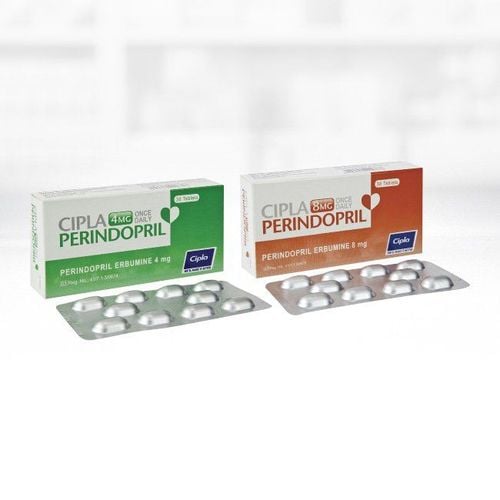This is an automatically translated article.
Rasoltan has the main ingredient Losartan 50 mg, which belongs to the group of drugs known as Angiotensin II (AT1) receptor blockers. Rasoltan is used alone or in combination with other drugs in the treatment of hypertension. Learning general information such as ingredients, uses, doses and side effects of Rasoltan medicine will help patients and their families improve treatment effectiveness.1. What is Rasoltan?
Rasoltan medicine is prepared in the form of film-coated tablets, with the main ingredients including:
Active ingredient: Losartan (as Losartan Potassium) content 50 mg. Excipients: Just enough for 1 film-coated tablet of 50 mg. Losartan is a new antihypertensive drug with an angiotensin II (AT1) receptor blocker mechanism. Angiotensin II is an active substance made from Angiotensin I through reactions under the catalysis of Angiotensin-converting enzyme (ACE).
Losartan and its major active metabolite inhibit the vasoconstrictor and aldosterone-secreting effects of Angiotensin II by selectively antagonizing Angiotensin II (AT1), preventing binding to the Angiotensin II (AT1) receptor present in many tissues. such as vascular smooth muscle, adrenal gland. Losartan has approximately 1000 times greater affinity for the Angiotensin II AT1 receptor than for the AT2 receptor.
2. What does Rasoltan do?
Rasoltan is indicated for treatment in the following cases:
Used alone or in combination with other drugs in the treatment of hypertension. Kidney disease in adults with hypertension. Renal disease in adults with type II diabetes with proteinuria > 0.5 g/day. Adjunctive treatment of chronic heart failure in adults who are intolerant or contraindicated to ACE inhibitors. As an adjunct to stroke prevention in hypertensive patients with electrocardiographically demonstrated superior ventricular hypertrophy. However, in the following cases, the drug Rasoltan is not allowed to be prescribed:
Hypersensitivity to any component of the drug Rasoltan. History of allergy to other drugs containing the active ingredient Losartan Potassium. History of allergy to Angiotensin II (AT1) receptor blockers. The patient is being treated with a potassium-sparing diuretic. Pregnant or lactating women. The patient has severely impaired liver function. Patients with severe renal impairment with serum creatinine ≥ 250 mmol/l or creatinine clearance ≤ 30 mL/min or serum potassium ≥ 5 mmol/l. Persons under 18 years old.
3. Dosage and how to use Rasoltan
Note: Use the drug when hungry or full.
3.1. Hypertension Adults:
Starting dose: Take 1⁄2 - 1 tablet (25 - 50 mg)/time x 1 time/day in the morning. Maintenance dose: Take 1-2 tablets (25 -100 mg)/time x 1-2 times/day. Dosage adjustment is recommended every 1 to 2 months. Elderly, renal failure or peritoneal dialysis
Dose: Take 1⁄2 tablets (25 mg)/time x 1 time/day in the morning. 3.2. Support for treatment of heart failure Dose: Take 1⁄2 - 1 tablet (25 - 50 mg)/time x 1 time/day. 3.3. Diabetic kidney disease Dose: Take 1-2 tablets (50-100 mg)/time x 1 time/day.
4. Side effects encountered when using Rasoltan:
The use of Rasoltan in high doses or for a long time, can cause side effects such as:
Common: Excessive hypotension, chest pain, insomnia, headache, dizziness, fatigue, low glucose blood, hyperkalemia, digestive disorders, diarrhea, dyspepsia, low hemoglobin and hematocrit, leg pain, muscle pain, back pain, hypouricemia, urinary infection, cough, sinusitis, nasal congestion . Uncommon: Sweating, chest pain, AV block I grade I, orthostatic hypotension, sinus bradycardia, tachycardia, palpitations, facial edema, facial flushing. Ataxia, confusion, depression, anxiety, migraine, headache, dizziness, sleep disturbance, fever, dermatitis, dry skin, hair loss, photosensitivity, bruises, rash, itching, hives. Gout, decreased sex drive, polyuria, nocturia, impotence, constipation, flatulence, vomiting, loss of appetite, loss of taste, gastritis, increased liver enzymes, increased bilirubin, tremor, bone pain, muscle weakness, paresthesia, joint edema, myalgia, conjunctivitis, decreased vision, blurred vision, burning and stinging eyes, tinnitus, slight elevation of creatinine or urea, bronchitis, epistaxis, rhinitis, dyspnea, swelling airway bleeding and throat discomfort. The drug should be stopped when detecting the above side effects or other unusual symptoms after taking Rasoltan, and promptly inform the treating doctor about the use of Rasoltan or go to the nearest medical facility immediately. for prompt treatment.
5. Note the use of Rasoltan in the subjects
Use caution when using Rasoltan in elderly patients, patients with severe renal impairment, patients with a history of or are suffering from unilateral or bilateral renal artery stenosis. The patient is being treated with diuretics and the patient has other predisposing factors for hypotension. Avoid using Rasoltan in people under 18 years of age because safety studies are still limited. Pregnant women: According to the classification of the US Food and Drug Administration (FDA), active ingredient Losartan belongs to group D, a group that definitely poses a risk to pregnancy. Therefore, the use of Rasoltan in pregnant women is contraindicated. Lactation: There are currently no reports confirming the presence of losartan in breast milk. Therefore, breast-feeding should be limited or discontinued when deciding to use Rasoltan in a nursing woman. Drivers or machine operators often experience side effects such as insomnia, headache, dizziness, fatigue ... after taking Rasoltan.
6. Rasoltan drug interactions:
Co-administration of Rasoltan with potassium-sparing diuretics, potassium-containing salt substitutes or potassium supplements may increase blood potassium. The following drugs reduce the concentration of Rasoltan in the blood: Rifampicin ; Aminoglutethimide; Carbamazepine ; Nafcillin; Nevirapine; Phenytoin . Rasoltan increases the effect of the following drugs: Amifostin ; Antihypertensive drugs; Carvedilol ; Blood sugar-lowering drugs; Lithium ; Potassium-sparing diuretics; Rituximab . Above is all information about Rasoltan drug, patients need to carefully read the instructions for use, consult a doctor / pharmacist before using. Rasoltan is a prescription drug, and patients should absolutely not self-treat at home because they may experience unwanted side effects.













